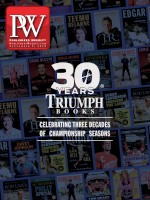This fall, National Geographic is kicking off a yearlong celebration of women to mark the 100th anniversary of the 19th Amendment. A special issue publishing in November will be the first in the magazine’s 131-year history to be written and photographed entirely by women. October sees the publication of Women: The National Geographic Image Collection, with an introduction and interviews by Susan Goldberg, editorial director of National Geographic Partners and the first woman editor-in-chief of National Geographic magazine. It’s one of several forthcoming titles that pull from rich archival material to illustrate women’s experiences and accomplishments.
Nat Geo’s 512-page hardcover, which “weighs a ton,” Goldberg says, was a year in the making, drawing from more than 60 million print and digital records: “You want to be inclusive and reflect the changes over time of how women were portrayed.” Archival depictions dating back 130 years include images of suffragists; the famed green-eyed “Afghan girl,” Sharbat Gula, from the magazine’s June 1985 cover; and many others. Goldberg also includes photos of and conducted interviews with a star-studded list of contemporary notable women, posing the same 11 questions to primatologist and anthropologist Jane Goodall, gun safety activist Emma González, and novelist Chimamanda Ngozi Adichie, among others. Taken as a whole, the book reads “like a powerful story that is just now reaching crescendo,” Goldberg says.
At Penguin Press, Vanity Fair’s Women on Women (Nov.), edited by Radhika Jones with David Friend, collects 28 feature articles about women, written by women. Jones, like Goldberg, achieved a milestone when she became Vanity Fair’s first female editor-in-chief in November 2017. Spanning 36 years, Women on Women includes profiles of Princess Diana, Whoopi Goldberg, and Lena Waithe, as well as Monica Lewinsky’s post-#MeToo take on the Clinton scandal. “This book is full of women who are not like anybody else,” Jones writes in her introduction. “Women who, in their singular ways, stood up for their lives, as they envisioned them, and in so doing, shaped the lives of multitudes.”
Phaidon is offering its own timely showcases, with Great Women Artists (Sept.) and Breaking Ground (Oct.), a study of architecture designed by women. Both had been on the agenda for years, says Virginia McLeod, commissioning editor for architecture, and both stemmed in part from examinations of Phaidon’s backlist. For instance, The Story of Art, first published in 1950, barely mentioned any women; 1994’s The Art Book represented some improvement, but not much.
“I was thinking, well, has there been enough research in the past 40 years, since the women’s art movement of the 1970s?” says Rebecca Morrill, commissioning editor for art. “Could I fill a similar book?” While there were a few skeptics in-house, she says, her team soon had a longlist of more than 2,000 names that they culled to 423: “There is absolutely no shortage.”



 Volume 266
Issue 36
09/09/2019
Volume 266
Issue 36
09/09/2019





